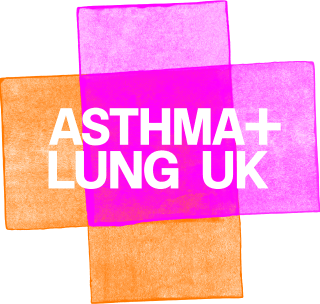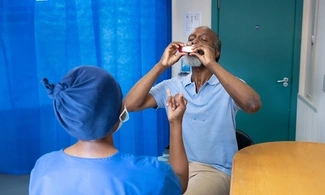What is home oxygen therapy?
Oxygen helps our body turn food into energy, which we need for growth, repair and movement. Healthy lungs take in oxygen from the air you breathe in and pass it into your bloodstream, so that it gets to every part of your body.
Some lung conditions stop your lungs getting enough oxygen into your blood. This can make the symptoms of your condition worse. If your oxygen levels are very low it can also put a strain on your heart.
Most people with a lung condition do not need extra oxygen. But if you’re living with a lung condition and your blood oxygen levels are very low, you may be offered home oxygen therapy. This involves breathing in air that has a higher level of oxygen through a mask or a tube connected to a device in your home or that you can carry around.
There are different kinds of home oxygen therapy:
- Long-term oxygen therapy (LTOT): used to keep your oxygen levels up for 15 hours a day or more
- Ambulatory oxygen therapy (AOT): portable oxygen used to help keep you active and mobile
- Palliative oxygen therapy (POT): used to manage very low oxygen levels at the end of life.
How can home oxygen therapy help?
Home oxygen therapy allows you to breathe air with more oxygen in it than normal. This helps to increase the amount of oxygen in your blood, which can:
- make it easier to do daily activities
- improve your sleep
- improve your concentration
- reduce the symptoms of your lung condition.
In people with very low oxygen levels, long term oxygen therapy for at least 15 hours a day can improve life expectancy.
Do I need home oxygen therapy?
You may be prescribed home oxygen therapy if you have one or more of the following conditions and have low blood oxygen levels:
Oxygen therapy is a treatment for low blood oxygen levels, not breathlessness
If you have problems with breathlessness but do not have low blood oxygen levels, it is not the right treatment for you. We have more information on managing breathlessness.
How are people assessed for home oxygen therapy?
If you have one or more of the conditions listed above and a low oxygen level, your doctor should consider whether home oxygen therapy could help you.
The oxygen levels in your blood can be measured using a small device clipped to your finger. This is called a pulse oximeter. If your oxygen levels are too low, they will refer you for a home oxygen assessment.
The assessment will take place at a specialist clinic, or at home if you’re not able to leave your home.
During the assessment, the healthcare professional will ask you about your medical history.
They will also take a blood sample from your wrist or earlobe to measure your oxygen levels. This test is more accurate than pulse oximetry.
You may then be asked to breathe oxygen through small tubes placed in your nostrils (a nasal cannula) for 30 minutes. After this the healthcare professional will take another sample. This is to see if the oxygen therapy has increased the oxygen levels in your blood without causing side effects.
You may have other tests including:
- spirometry, which measures how much air you can breathe out in one forced breath
- a walking test on a treadmill, or a stepping test if the assessment is at home. This test may be repeated with an oxygen supply to see if it helps you
- an ECG (electrocardiogram) and echocardiogram, to see how well your heart is working. If you have heart problems as well as a lung condition, you may benefit from oxygen therapy at an earlier stage.
You will usually need to have another blood test three weeks after your first assessment before oxygen is prescribed. This is to check that your oxygen levels have not improved.
Smoking and oxygen therapy
At your assessment, the healthcare professional will ask you if you or anyone you live with smokes. Oxygen makes things catch fire much more easily and more fiercely, so it is not safe to smoke near it.
If you smoke, you will not be able to have home oxygen therapy unless you quit. Quitting smoking is also the best thing you can do for your lung health. If you smoke, we have lots of advice on stopping smoking.
What happens if I need home oxygen therapy?
If the healthcare professional who assesses you decides that home oxygen therapy could help, they will prescribe you the right amount of oxygen. They should tell you:
- how your oxygen will be delivered
- what your oxygen flow rate should be (how many litres per minute of extra oxygen)
- how many hours a day you should use your oxygen.
You should also be given written information about your oxygen therapy.
You will have a risk assessment to make sure there are no tripping hazards or fire hazards in your home.
How often will my home oxygen therapy be reviewed?
You should have another blood test within three months of starting home oxygen therapy, to check it’s working. Your oxygen therapy should then be reviewed at least once a year.
You should also have another home risk assessment within three months of starting home oxygen therapy. You should then have a risk assessment review every year you’re having oxygen therapy.
If your condition gets worse, your oxygen therapy may be reassessed to make sure you’re getting the right amount of oxygen.

Get support
Call our helpline for support with your condition. Get advice on your medicines, symptoms or travelling with a lung condition, or just call us to say hello.








